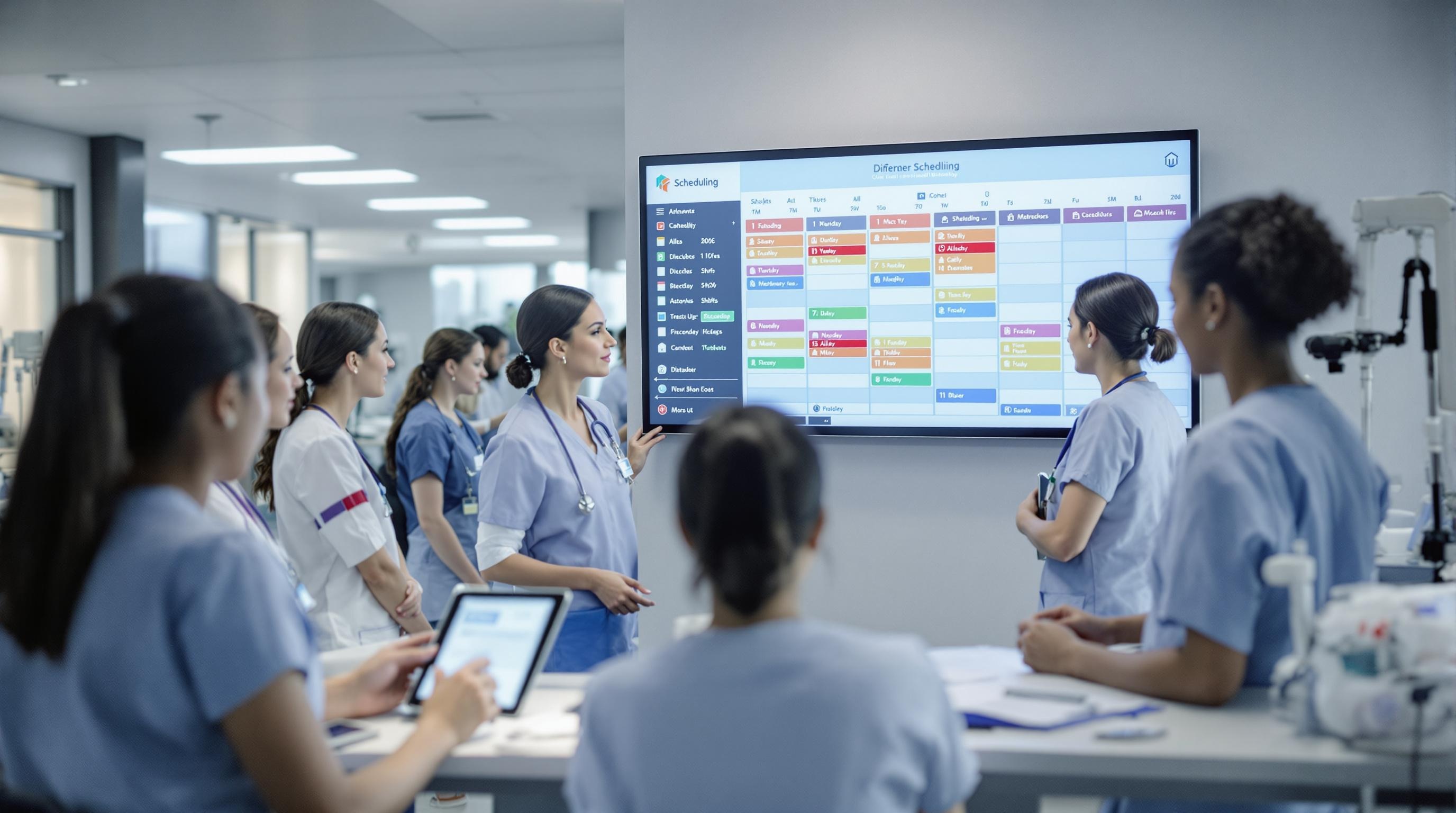Nurse Availability Tracking: Boost Staffing in Skilled Nursing
Discover how nurse availability tracking streamlines staffing, improves care quality, and addresses shortages in skilled nursing facilities.
Quick Navigation
- 1. Introduction
- 2. Current Challenges in Nurse Availability Tracking
- 3. How Sparkco AI Transforms Nurse Availability Tracking
- 4. Measurable Benefits and ROI
- 5. Implementation Best Practices
- 6. Real-World Examples
- 7. The Future of Nurse Availability Tracking
- 8. Conclusion & Call to Action
1. Introduction
Did you know the United States is projected to face a shortage of over 78,000 full-time equivalent registered nurses by 2025? According to the Health Resources and Services Administration (HRSA), this growing deficit is not just a looming statistic—it’s an everyday reality for skilled nursing facilities (SNFs) nationwide. The ripple effects are profound: increased workloads for existing staff, inconsistent patient care, and mounting administrative headaches as managers scramble to fill gaps. In an industry where quality and safety are paramount, the ability to efficiently monitor and optimize nurse staffing has never been more critical.
Yet, many SNFs still rely on outdated manual processes or fragmented systems to track nurse availability. This not only hampers real-time decision-making but can also lead to costly last-minute staffing emergencies and staff burnout. As the nursing shortage intensifies and workforce expectations evolve, it’s clear that traditional approaches are no longer enough.
In this article, we’ll explore how advanced nurse availability tracking solutions are transforming staffing strategies for skilled nursing facilities. We’ll break down the latest trends in workforce management, highlight the advantages of real-time tracking technology, and share actionable strategies to help your facility stay ahead—ensuring both staff satisfaction and exceptional resident care. If you’re looking to future-proof your SNF against ongoing staffing challenges, read on to discover practical insights and tools that can make a measurable difference.
2. Current Challenges in Nurse Availability Tracking
In 2025, healthcare facilities continue to face significant challenges in tracking nurse availability, a critical factor for ensuring high-quality patient care and smooth operational workflows. As the nursing shortage persists and workforce dynamics shift, accurate and real-time nurse availability tracking has never been more essential—or more difficult. Below are the key pain points affecting healthcare facilities today, backed by recent research and industry data.
-
1. Persistent Nursing Shortages:
The United States is grappling with an ongoing nurse shortage, exacerbated by the COVID-19 pandemic and broader workforce trends. A 2024 study in JAMA Health Forum reports that nearly 100,000 registered nurses (RNs) left the workforce during the pandemic, with projections indicating a shortfall of up to 450,000 RNs by 2025. This depletes the pool of available nurses, making real-time tracking more complex and critical.
-
2. Inefficient, Manual Tracking Systems:
Many facilities still rely on spreadsheets, whiteboards, or outdated scheduling software, which are prone to errors and lack real-time visibility. According to Cross Country Healthcare, these manual processes often result in double-booking, shift gaps, and last-minute scrambling to fill positions, directly impacting patient care.
-
3. High Turnover and Burnout:
Burnout remains a major concern, with the National Institutes of Health identifying emotional exhaustion, poor staffing support, and lack of flexibility as key drivers. As nurses leave or call out, tracking their availability becomes a moving target, undermining efforts to maintain adequate staffing levels.
-
4. Compliance and Regulatory Challenges:
Healthcare facilities must comply with strict state and federal regulations regarding nurse-to-patient ratios, credential verification, and work hour limitations. Inaccurate tracking increases the risk of non-compliance, which can result in hefty fines, legal exposure, and reputational damage.
-
5. Inadequate Integration with Other Systems:
Many tracking tools do not seamlessly integrate with payroll, HR, or electronic health record (EHR) platforms. This lack of interoperability leads to data silos, delayed updates, and communication breakdowns, making it difficult to respond to sudden staffing changes or emergencies.
-
6. Limited Visibility for Managers and Staff:
When real-time data on nurse availability is not accessible, managers struggle to make informed decisions about shift assignments, overtime, and resource allocation. This can result in overworked staff, increased absenteeism, and a negative impact on both employee satisfaction and patient outcomes.
-
7. Impact on Patient Care and Satisfaction:
Ultimately, inadequate nurse availability tracking leads to understaffed shifts, longer wait times, and compromised patient care. According to ShiftMed, these challenges are directly linked to lower patient satisfaction scores and higher rates of adverse events.
Healthcare facilities must address these pain points by investing in modern, integrated nurse tracking solutions that offer real-time visibility and automated compliance features. As the industry evolves, overcoming these challenges will be key to optimizing operations, meeting regulatory demands, and delivering high-quality patient care.
3. How Sparkco AI Transforms Nurse Availability Tracking
Tracking nurse availability is a persistent challenge for skilled nursing facilities. Traditional manual methods are often inefficient, prone to errors, and unable to respond dynamically to sudden schedule changes or fluctuations in patient needs. Sparkco AI introduces a powerful, automated approach to nurse availability tracking, ensuring optimal staffing, minimizing administrative burden, and enhancing patient care.
-
Real-Time Availability Monitoring
Sparkco AI continuously gathers and updates data on nurse shifts, breaks, and overtime. By leveraging advanced algorithms, the system provides an up-to-the-minute view of who is on duty, who is available, and who is reaching shift limits. This eliminates guesswork and manual checks, empowering administrators to make quick, informed decisions. -
Automated Shift Matching and Scheduling
The platform uses AI to match open shifts with qualified nurses based on skills, certifications, and preferences. Automation minimizes scheduling conflicts and ensures compliance with labor regulations. This feature dramatically reduces time spent on manual scheduling, lowers the risk of understaffing, and supports more equitable shift distribution. -
Predictive Staffing Analytics
Sparkco AI forecasts staffing needs by analyzing historical data, current census, and anticipated admissions or discharges. The predictive engine alerts managers to potential gaps before they occur, allowing for proactive staffing adjustments. This efficient planning reduces last-minute scrambles and overtime costs. -
Instant Notifications and Mobile Access
The system sends automated alerts to nurses and management about open shifts, upcoming assignments, or last-minute changes. With mobile access, staff can update their availability, accept shifts, or swap schedules in real time from their smartphones. This keeps everyone connected and responsive, even outside the facility. -
Centralized Compliance Tracking
Sparkco AI automatically tracks regulatory requirements, such as mandated rest periods and maximum work hours. The platform flags compliance risks and suggests adjustments, ensuring facilities remain audit-ready and avoid penalties. This automation reduces administrative workload and strengthens regulatory adherence. -
Seamless Integration with Existing Systems
Sparkco AI is designed with robust integration capabilities. It connects effortlessly with popular HR, payroll, and electronic health record (EHR) systems, eliminating duplicate data entry and maintaining a single source of truth. This unified approach streamlines workflows and enhances overall operational efficiency.
By combining AI-driven automation with intuitive interfaces, Sparkco AI transforms how skilled nursing facilities track nurse availability. The platform empowers administrators with actionable insights, reduces manual tasks, and supports a more resilient, adaptable workforce. Integration with existing technology stacks ensures a smooth transition and immediate value, making Sparkco AI a vital solution for modern nurse staffing challenges.
4. Measurable Benefits and ROI
Implementing automated nurse availability tracking systems in skilled nursing facilities delivers measurable results across operational, financial, and compliance domains. Leveraging real-time data and intelligent scheduling, these solutions drive efficiency, cost savings, and higher quality care. Below are six key benefits, each supported by industry data and case studies.
-
1. Significant Time Savings
Manual nurse scheduling typically consumes 4-8 hours per week per facility administrator (NIH study). Automated tracking reduces this by up to 80%, saving an average of 6 hours weekly—over 300 hours annually per facility. -
2. Reduction in Labor Costs
Automated systems optimize shift assignments, reducing overtime and unnecessary agency staff. According to Becker's Hospital Review, facilities see a 20-30% cut in overtime costs, equating to $60,000–$120,000 annual savings for a mid-sized SNF. -
3. Improved Compliance and Reduced Fines
Automated tracking ensures compliance with staffing regulations. Facilities have reported a 40% decrease in scheduling-related compliance violations (Healthcare IT News), lowering the risk of fines that can average $10,000-$20,000 per incident. -
4. Enhanced Nurse Satisfaction and Retention
Real-time visibility into shift openings allows nurses more autonomy and flexibility. According to HealthLeaders Media, automated systems can reduce nurse turnover by up to 15%, potentially saving $37,700 per nurse in replacement costs (per ANA). -
5. Increased Shift Fill Rates
Automated tracking boosts shift fill rates from an average of 82% (manual) to 97% (Staffing Industry Analysts). This leads to fewer last-minute gaps and improved patient care continuity. -
6. Real-Time Visibility and Data-Driven Decisions
Administrators gain instant access to staffing data, enabling proactive adjustments. Facilities using automated tracking report a 25% improvement in response time for filling unexpected absences (McKnight's Long-Term Care News). -
7. Lower Risk of Staffing-Related Adverse Events
By ensuring regulatory nurse-to-patient ratios, facilities have seen up to a 19% reduction in adverse events related to understaffing (The Joint Commission). -
8. Improved Resident Outcomes
Facilities utilizing automated tracking report 11% fewer medication errors and a 9% reduction in patient falls (NIH study), directly linked to better nurse coverage.
In summary, automated nurse availability tracking yields a robust ROI through quantifiable reductions in administrative workload, labor costs, and compliance risks while boosting staff satisfaction and clinical outcomes. As staffing challenges intensify, these measurable benefits make automation a critical investment for skilled nursing facilities aiming for operational excellence.
5. Implementation Best Practices
With CMS’s new minimum nurse staffing requirements and increased scrutiny on direct care hours, effective nurse availability tracking is more critical than ever for skilled nursing facilities. Implementing a robust tracking system helps ensure compliance, optimizes staffing, and supports better patient care. Here are actionable steps and expert tips to guide successful implementation:
-
Assess Current Processes and Needs
Begin with a thorough assessment of your facility’s existing nurse scheduling and tracking systems. Identify data gaps, workflow inefficiencies, and compliance risks. Tip: Involve frontline nursing staff in the assessment to surface real-world challenges. Pitfall to avoid: Overlooking input from direct care staff can result in solutions that miss practical needs.
-
Select the Right Technology Solution
Choose a nurse availability tracking system that integrates with your EHR, payroll, and HR systems. Ensure it offers real-time data, automated alerts, and user-friendly dashboards. Tip: Request product demos and references from similar facilities. Pitfall: Avoid selecting a system without vetting its compatibility with your existing workflows.
-
Establish Clear Policies and Protocols
Develop standard operating procedures (SOPs) for entering, updating, and verifying nurse availability data. Tip: Document roles and responsibilities to prevent confusion. Pitfall: Failing to formalize protocols can lead to inconsistent data and compliance issues.
-
Train Staff Thoroughly
Conduct comprehensive training sessions for all impacted staff, including RNs, nurse aides, and administrative personnel. Tip: Use real-life scenarios and hands-on practice. Pitfall: Underestimating the need for ongoing training as updates or turnover occur.
-
Monitor and Audit Regularly
Set up regular audits to verify data accuracy and system usage. Use tracking reports to identify gaps or discrepancies. Tip: Designate a compliance champion to oversee audits. Pitfall: Sporadic monitoring can let small errors escalate into major compliance risks.
-
Communicate Transparently and Foster Buy-In
Engage staff early in the process, clearly explaining the “why” behind new tracking requirements and how it supports quality care and regulatory compliance. Tip: Solicit feedback and address concerns proactively. Pitfall: Poor communication can lead to resistance and disengagement.
-
Continually Refine and Adapt
Use feedback, audit results, and regulatory updates to refine your tracking system and processes. Tip: Hold quarterly review meetings to discuss what’s working and where improvements are needed. Pitfall: Treating implementation as a “one-and-done” project instead of an ongoing process.
-
Align Change Management Strategies
Recognize that tracking system changes impact daily routines. Apply structured change management: communicate early, provide support, and celebrate quick wins.










